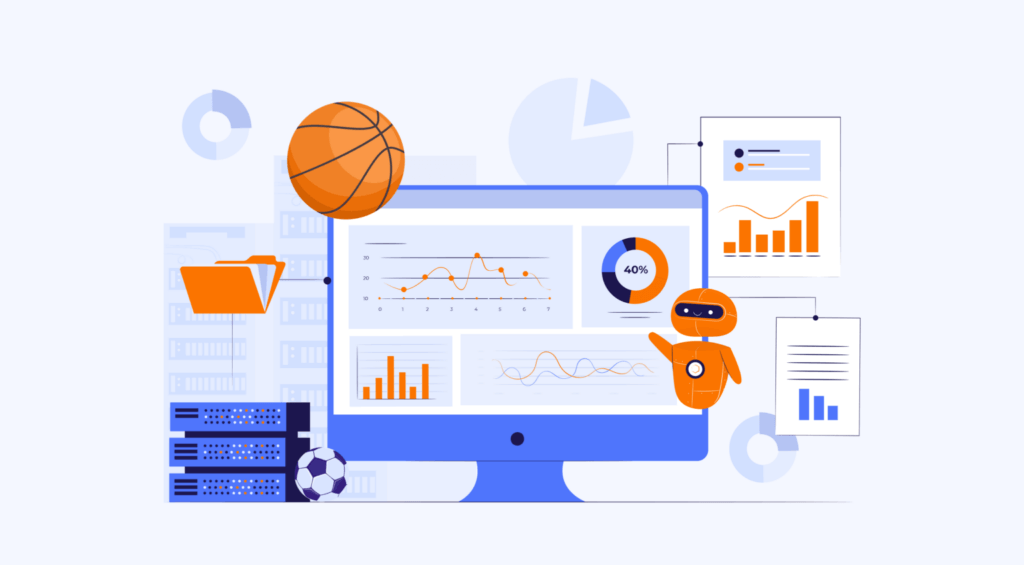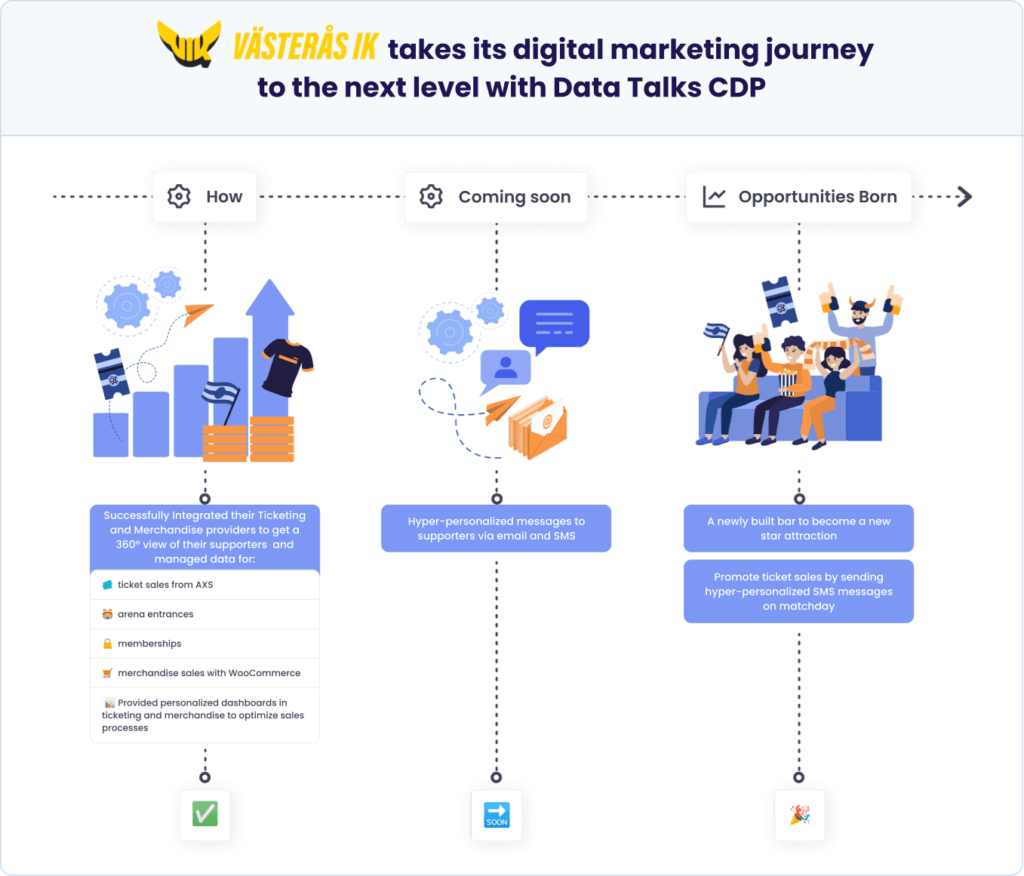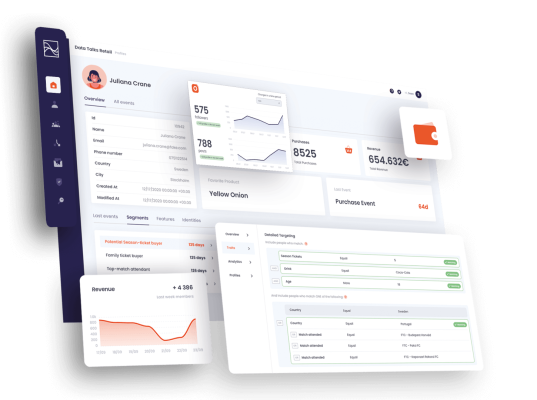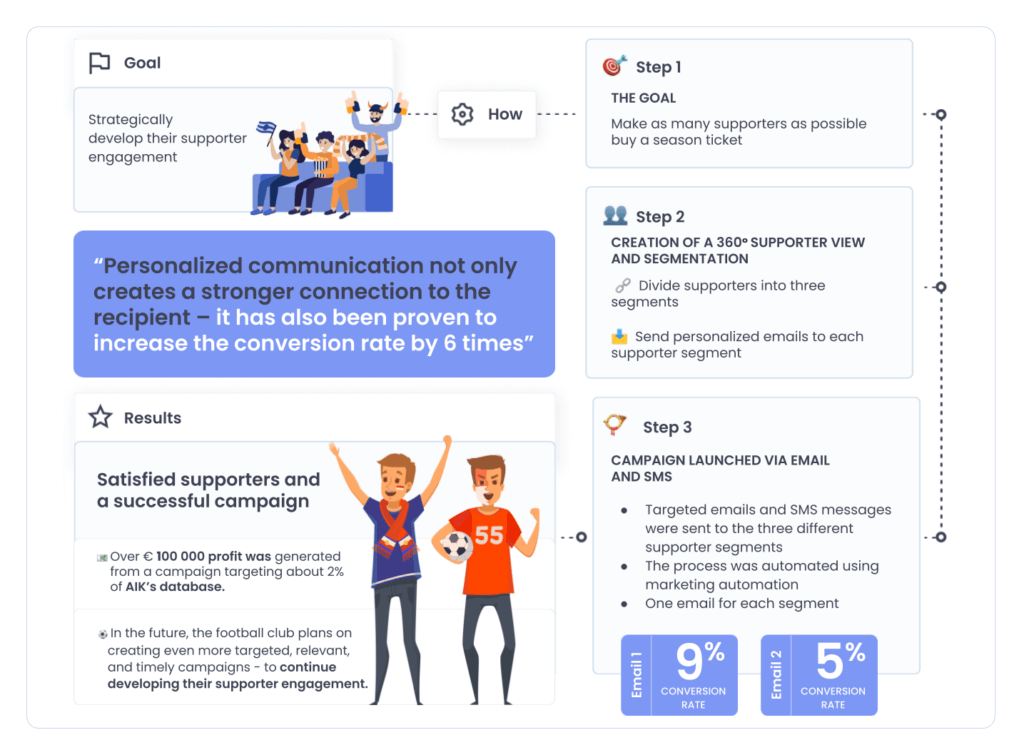
As the naturalist and biologist Charles Darwin once said, “it is not the strongest or the most intelligent who will survive but those who can best manage change.” The concept of adapting to change is so intimately known by humans that it is ingrained in us. In our survival mechanism. Then why is it that when it comes to our places of business, our beloved sports organizations, this idea seems to go out the window? The sports industry in particular has done a great job of avoiding change. But it would appear that this resistance to change is quickly coming to a change. What with all the talk about working data driven. But how can an organization create a data driven culture? We discuss this and more in this blog post.
Before we dive right in...
Subscribe to our blog today to ensure that you never miss valuable posts such as this one. We are passionate about helping sports organizations deliver a world-class fan experience, because better fan experience means better business. So why not use this opportunity to the fullest?

Is a data driven culture really inevitable?
We are living in the fastest-changing communications technology landscape than ever before. New software and applications are sprouting up like mushrooms. Would you be the one to bet on this changing soon and slowing down? That choice would be counter-trends and research indeed.
Think about it, fifty years ago, the majority of people did not have email addresses. But nowadays it’s virtually impossible to conduct any kind of process in your sports organization without an email.
Less than twenty years ago Facebook didn’t exist. But now it has been downloaded by at least 5 billion people. That is more than 60% of the world population. Humanity has become more technological. So, “if you can’t beat them, join them”, right?
This is where working data driven comes into play.

What does working data driven mean?
Working data driven simply means making strategic decisions based on the analysis and interpretation of data. And what is this data? In our case, within sports organizations, it means supporter data. Data such as:
- Who your supporters are – age, sex, location
- How you can contact your supporters – email, phone number, etc
- How often do your supporters interact with you
- Their purchase behavior
- Their behavior when they are on your website
And why do you work data driven in the first place?
To give your supporters what they want. If your supporters have become more technologically advanced, they would naturally expect the same from you. For example, supporters expect you to meet them where they are. So if they are online, guess where you have to go? Online. Other examples of changed supporter expectations are the need for seamless online transactions and for your online and offline supporter experiences to be seamless too. How are you expected to keep up with this? Certainly not by using excel sheets and keeping files in old school cabinets and lockers.
You can keep up with your supporters and exceed their expectations only by working data driven.

Find out how you can go omnichannel
and get answers to questions like, what an omnichannel approach is, why adopting one is crucial and how you can create a successful omnichannel strategy by reading our omnichannel guide. The more you read the more confident you will become about heading down this path.
But here’s the problem …
More often than not, when decision-makers in the sports organization, such as management, think about working data driven, they think of this as a challenge to be tackled. Instead of looking at it as an opportunity to be used to its full potential. This problem does not stop with just management though. Are your teammates embracing the idea of working data driven or do they think it’s too much effort? That is why it is important to ensure that you create a data driven culture within your sports organization. To truly ensure that you get the full benefits of working data driven. So let’s look at all the ways you can create a data driven culture in your sports organization.
How to create a data driven culture within your organization

Start at the top

Top management needs to understand the importance of working data driven and then embrace this fully. They need to lead by example and set that expectation of working data driven. Here are several examples of how to do this:
- Chief Marketing Officers – let’s say you have a goal to increase inbound online ticket sales. So now you are deciding on ways to communicate this to do exactly just that. What are these brilliant ideas you are coming up with based on? Are you empowering your team to use whatever data is available to them to uncover purchase patterns and web behavior that will increase the likelihood of your supporters buying tickets? Furthermore, have you ensured that the process of buying is seamless and meets the supporters’ expectations?
- Chief Commercial Officers – are the solutions you are choosing to invest in for your sports organization in line with your data driven ambitions? Or are you still using traditional methods and in effect saying one thing and then doing another? You have to be constantly looking for best practices on how to make your team more data-driven in practical ways.
- Chief Financial Officers – you play a central role in the culture of the organization because you are the one who allocates the appropriate budget. Are you refusing to release funds for your team to become more data driven? Have you been educating yourself on best practices so that your team knows you are fully behind them on their journey?
These are just a few considerations. There are so many ways that management can lead by example when trying to create a data driven culture.

Communicate why you’re going data driven with the rest of your team

Communication is key. We cannot stress this enough. Communication is key.
Making changes and adopting a “because management decided so” approach does not work. Instead, you have to communicate your vision with your team. Not only that, but you have to be willing to answer any questions they have. Fortunately, the benefits of working data driven are so massive that you don’t have to squirm when communicating them.
Proper communication will help you:
- Ease the process of becoming data driven
- Create synergy in the team where everyone in the team understands the goal and purpose of working on data driven
- Get the full cooperation of everyone involved, that is, the whole team
- Create trust and a sense of belonging within the team and management
So ensure that you understand the vision and how everyone in the team can help support that vision.

Improve data-transparency

This is a huge one. You simply cannot preach a culture that is unattainable. Otherwise, it becomes a wish that becomes a hurdle because you are communicating a vision without a roadmap. The most paramount aspect of adopting a data driven culture is the tools you choose. There is so much information on the internet that some organizations have been easily led astray. For example, maybe you purchased a tool that promised one thing but in reality, could not deliver. We understand this struggle. This is an area we are hugely passionate about and work with sports organizations, like yours, to solve.
So what is data transparency? Well, according to PC Mag, data transparency is:
(1) The ability to easily access and work with data no matter where they are located or what application created them.
(2) The assurance that data being reported are accurate and are coming from the official source.
Now, do you understand why data transparency is important? Your data needs to always be easily accessible and accurate, otherwise, your efforts are for nothing. So what’s the solution? A sports CDP.
How a sports CDP can help you foster a data driven culture in your organization

We asked one of our customers to tell us about their experience working with a CDP, Kevin – business to consumer manager at Västerås IK. And this is what he had to say:
“I myself was born in the 90s, and I know that many people use digital services in their daily lives. Our whole society has changed over the years, and we as a sports business need to follow in the same direction.
At the same time, I realized how many people were involved in all our data sources. I understood that we needed a robust solution that could connect everything and keep it all in order. Because everyone at the club needs to have the right data about the right people. Only then would we be able to truly develop and grow our club. We have 150’000 people in the city and about 200’000 in our close region.
Obviously then, we needed the right tools and resources to reach all of these people and communicate with them in a way that was simple and logical. So from that point, it felt clear what we needed to do to get this going.
We probably had between 5-6 different systems. None of them were connected to one another and the database references were in excel files. Simply put, it was all a big mess. It was so hard to manage all our data.
To give an example, if one of our supporters would make some changes to their data in one of our systems, I had to manually update that same data in systems 1, 2, 3, 4, etc, accordingly. It’s both a nightmare and an impossible task to do timewise. We were wasting so much time and energy, which in turn was building up frustration within me since I’m the one responsible for all of this.
Fortunately, we realized that it wasn’t sustainable to keep doing things like this and that we, indeed, needed a CDP. And from that point forward, we became so much more efficient and so much better. Thanks to my own experience of working with a CDP at another club, I realized that we need a CDP in order to work data-driven. It was an eye-opener for me that I cannot work without a CDP”

… I realized that we need a CDP in order to work data-driven. It was an eye-opener for me that I cannot work without a CDP
– Kevin Johansson | Business to Consumer Manager at Västerås IK
How a sports CDP helps you with data-transparency?
In a nutshell, a CDP:
- Keeps your data organized, unified, and stored in one place. And whenever a supporter interacts with you, the CDP automatically updates the data in real-time. You will have peace of mind knowing that you don’t need to monitor the data like a hawk. Additionally, this saves you time. Just like Kevin from Västerås, you won’t have to worry about manually updating your data.
- Can be integrated with other systems such as your ticketing system, Customer Relationship Management system (CRM), and automation system. Meaning your data can be seamlessly shared across all these systems.
- Furthermore, this data can be shared with other departments and not just systems. So, you can say goodbye to lag when it comes to decision-making. The whole team will effectively be on the same page, at all times.
With a CDP, you can put your money where your mouth is by ensuring that everyone in the whole organization is on board. Thus creating the perfect data driven culture. In the process, you will reduce confusion, wasted time, and effort. This is especially important in the face of new changes. Your team is more likely to buy into working data driven when there is a solid structure in place to support them.

To see how this would look in action, explore the Data Talks CDP demo >>

Measure the before and after
Something we encourage all sports organizations before starting their CDP implementation is to measure the cost of doing nothing first. We are all unanimous that doing nothing is the last thing any sports organization should be doing. Because the cost is way too high. But then the second step, after employing a CDP as an integral part of your data-driven culture overhaul, is to measure the results. It’s one thing to tell people that something works and it’s entirely another to show them. We have already looked at what Kevin from Västerås thought about the CDP, let’s look at another example.
How AIK generated 6 figures during one marketing campaign

This is one of my favorite success stories because it shows that the CDP really works. The main part of why you are choosing to adopt a data driven culture is for this very reason. To make more money than you have ever done before. And with very little effort. Right now will all your numerous outdated and old-fashioned systems you are having to work hard to make money. But why work harder when you can work smarter and save time while making a killing?
This is exactly what AIK did. They created a campaign with the CDP where they only targeted about 2% of their supporter database. The goal? To get as many people as possible to buy a season ticket. During the campaign, they retargeted supporters who had received their email but not purchased tickets. Do you know how long it took them to generate the 6 figures? 2 weeks. You read that right! Not months but weeks. This too could be you. Why wait for the future when you can enjoy these benefits today?

Applaud your team

Last but certainly not least on how you can create a data driven culture is, that you have to applaud your team. Embracing change can be very difficult. So if your team has done incredibly well in implementing all the changes, you have to encourage them by celebrating them. One might say, “well it’s part of their job, so why should you have to celebrate them?”. And to that we say, applauding your team is important because:
- It gives the team motivation to keep going and keep improving
- A strong culture of praise and encouragement increases engagement and productivity. It helps team members take ownership of their work
- It helps build the team’s resilience and readiness to tackle any future challenges that might come in the future.
So celebrate your team!
Conclusion
Working data driven in today’s climate is non-negotiable. That’s because:
- Your supporters are digitally savvy and working data driven is the only way to ensure that you can reach them
- They have high expectations that cannot be met through the old ways of working
- Working data driven is the only way that your sports organization can survive in this highly competitive digital landscape we live and operate in.
So ensuring that you get buy-in from your team to realize your dream of a data driven culture becomes crucial. So it is important that you:
- Start this process by making sure that all management understands the importance of having a data driven culture
- Communicate fully with your team about this
- Improve your data transparency by using a sports CDP, the only solution out there capable of fulfilling all your data needs
- Measure the before and after results to prove to yourself and the team that a data driven culture makes all the difference for your sports organization.
- Last but not least, celebrate your team for the amazing work they do.
